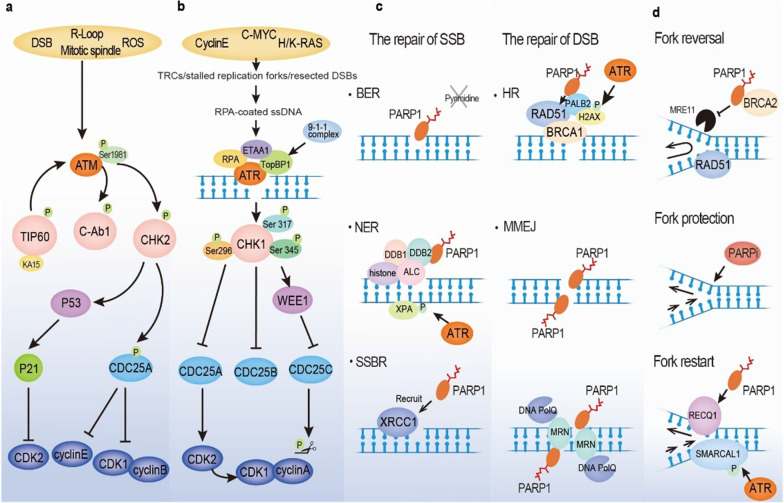Fig. 2.
Multiple roles of two cell cycle checkpoint pathways (ATM/CHK2/TP53 and ATR/CHK1/WEE1) and PARP1 in the DNA damage response (DDR) and replication stress (RS) response. a ATM is stimulated by a few activators or via autophosphorylation through a feedback loop. ATM activates CHK2, which subsequently phosphorylates TP53 and CDC25A, leading to inhibition of CDK2/cyclin E and CDK1/cyclin B and impairment of G1/S phase transition. b Major trigger for ATR is stalled replication fork or resected DSB. The activation of ATR requires RPA-coated ssDNA, ETAA1, and TopBP1. Then, ATR mediates CHK1 phosphorylation, suppressing CDC25A and CDC25B and stimulating WEE1 activity. Alternatively, WEE1 inhibits CDC25C by phosphorylating CDC25C. The inactivation of the CDC family causes CDK2 and CDK1 incompetence, resulting in G2/M phase arrest. c PARP 1 senses single-strand DNA breaks and catalyzes other prominent members and itself through PARPylation, participating in BER, SSBR, and NER. Finally, poly(ADP-ribose) glycohydrolase (PARG) and PARylation itself release PARP1 from SSB sites. Similarly, PARP1 senses DSBs and recruits ATM, MRE11 and BRCA proteins to repair DNA strands via HR or facilitates MMEJ repair pathway activation in the absence of BRCA. d PARP1 plays key roles in fork reversal, fork protection and fork restart during the repair of stalled replication forks. PARP1 Poly(ADP-ribose) polymerase 1; DDR DNA damage response; RS Replication stress; BER Base excision repair; SSBR Single-strand break repair; NER Nucleotide excision repair; PARG Poly (ADP-ribose) glycohydrolase; SSBs Single-strand breaks; DSBs DNA double-strand breaks; ATM Ataxia–telangiectasia mutant; MRE11 Meiotic recombination 11 homolog 1; BRCA Breast cancer susceptibility gene; HR Homologous recombination; MMEJ Microhomology-mediated end joining

